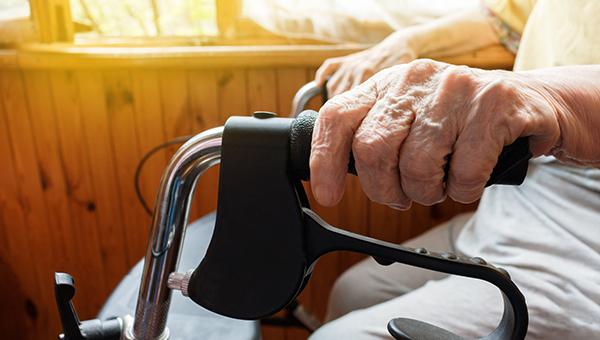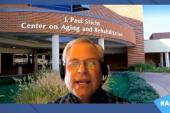Guideline-Directed Therapies Underused in Frail HF Patients
HF specialists often do exactly the opposite of what they should be doing for those most at risk, editorialists say.

Optimal guideline-directed medical therapy (GDMT) is prescribed less often in frail patients with heart failure with reduced ejection fraction (HFrEF) than in nonfrail patients, and they may be more likely to die or be hospitalized as a result, an analysis from the GUIDE-IT study shows.
“There's a big implementation gap in getting these therapies to patients who are high-risk and who need them the most,” senior author Ambarish Pandey, MD, MSCS (University of Texas Southwestern Medical Center, Dallas), told TCTMD. “The first step would be to identify frail patients in our clinical setting, which we don't do a good job of, and I think that's where we need to start.”
In their analysis, Pandey and colleagues led by Muhammad Shahzeb Khan, MD, MSc (Duke University School of Medicine, Durham, NC), found that frailty was an independent predictor of mortality and hospitalization, and that the higher the degree of frailty a patient had, the less likely they were to have any GDMT uptitrated or initiated.
The GUIDE-IT data are in line with those of prior studies, including CHAMP-HF, which showed significant underutilization of GDMT in HFrEF patients. Even when prescribed, less than 1% of patients in that study received the target dose of any GDMT.
“To put it short, we do exactly the opposite of what we are supposed to do in patients that need it the most,” write Nathan Mewton, MD, PhD, and Laurent Sebbag, MD, PhD (both Louis Pradel Cardiovascular Hospital, Lyon, France), in an editorial accompanying the study. “On every visit we should seize the opportunity for optimization.”
The study was published this week in JACC: Heart Failure.
GUIDE-IT Trial
Khan and colleagues performed a post hoc analysis of 879 HFrEF patients enrolled in GUIDE-IT. To assess frailty, they used an index based on a 38-variable deficit model, and categorized patients into groups of nonfrail (18.5%), intermediate frailty (25.1%), and high frailty (56.3%). Compared with those who were not frail, patients with a higher frailty burden were older, had higher BMI, higher N-terminal pro-brain natriuretic peptide (NT-proBNP) levels, and a higher burden of comorbidities, including diabetes, atrial fibrillation, kidney disease, stroke, and depression. Baseline use of triple- and double-therapy regimens was suboptimal across all frailty groups.
For the primary composite endpoint of HF hospitalization or CV mortality, there was a stepwise increase in risk across the nonfrail, intermediate, and high-frailty groups (22.7% vs 33.0% vs 43.2%; log-rank P < 0.001). Even after adjusting for HF severity, having a high frailty score continued to be associated with greater risk of adverse outcomes compared with being nonfrail (HR 1.76; 95% CI 1.20-2.58). The high frailty group had greater risks of all-cause mortality (HR 2.55; 95% CI: 1.25-5.20) and first HF hospitalization (HR 1.61; 95% CI: 1.08-2.40) compared with the nonfrail group.
Conversely, there was a greater likelihood that nonfrail patients would be started on double or triple optimal GDMT compared with high-frailty patients. Looking at individual components of GDMT, there was greater uptitration of ACE inhibitors/ARBs and beta-blockers in nonfrail and intermediate-frailty patients compared with high-frailty patients.
An additional exploratory analysis showed that high-frailty patients who were on triple therapy at baseline had a nonsignificant, but numerically lower rate of the primary composite endpoint compared with high-frailty patients not on triple therapy (P = 0.06). Importantly, rates of drug-related adverse events, including symptomatic hypotension, hyperkalemia, and worsening renal function, were low and similar across the frail and nonfrail groups.
Need for Frequent Frailty Assessment
One possible reason for underutilization of GDMT in frail patients may be that physicians are worried about adverse effects or intolerance to double and triple therapies, the investigators say.
“We did not see an increased risk that was disproportionate between nonfrail patients and frail patients on GDMT,” Pandey said.
In their editorial, Mewton and Sebbag say there needs to be greater emphasis in HF care on integrating frailty assessment using widely available, validated frailty scores. However, they also advise against relying on drugs alone for treating frailty, noting that recent results from the REHAB-HF trial, which used tailored cardiac rehab in frail, decompensated HF patients, “clearly pave the way towards improvement in quality-of-life outcomes that should be our primary goal in frail HF patients.”
To TCTMD, Pandey said appropriate frailty assessment is key to tailoring GDMT, and it isn’t as complicated or time-consuming as some physicians may think.
“I think that a lot of the hesitancy with doing frailty assessment is mostly [related to] nonfamiliarity with these tools,” he said. “You need to get in the habit of using them.” Pandey added that frailty should typically be assessed at the first visit and again once a year, or whenever there is decompensation or a clinical event that modifies the patient’s clinical profile.
L.A. McKeown is a Senior Medical Journalist for TCTMD, the Section Editor of CV Team Forum, and Senior Medical…
Read Full BioSources
Khan MS, Segar MW, Usman MS, et al. Frailty, guideline-directed medical therapy, and outcomes in heart failure with reduced ejection fraction: the GUIDE-IT trial. J Am Coll Cardiol HF. 2022;Epub ahead of print.
Mewton N, Sebbag L. Don’t be frail to optimize heart failure therapies! J Am Coll Cardiol HF. 2022;Epub ahead of print.
Disclosures
- The study was funded by grants from the National Institutes of Health and by support for testing from Roche Diagnostics.
- Khan reports no relevant conflicts of interest.
- Pandey reports having served on the advisory board of Roche Diagnostics.
- Mewton and Sebbag report having received honorary or consultant funds from Novartis, AstraZeneca, Boehringer Ingelheim, Amgen, Bayer, Vifor Pharma, Merck Sharp & Dohme, and Bristol Myers Squibb.





Comments